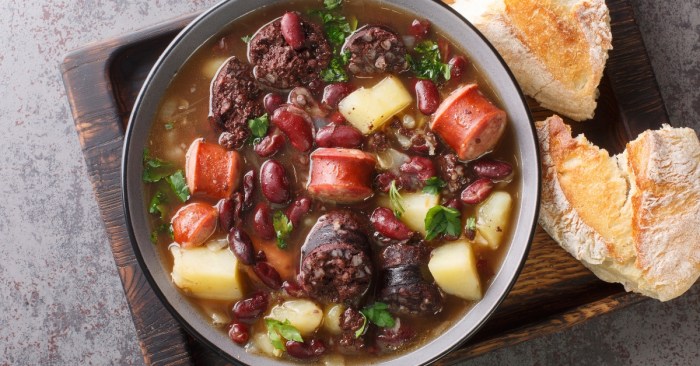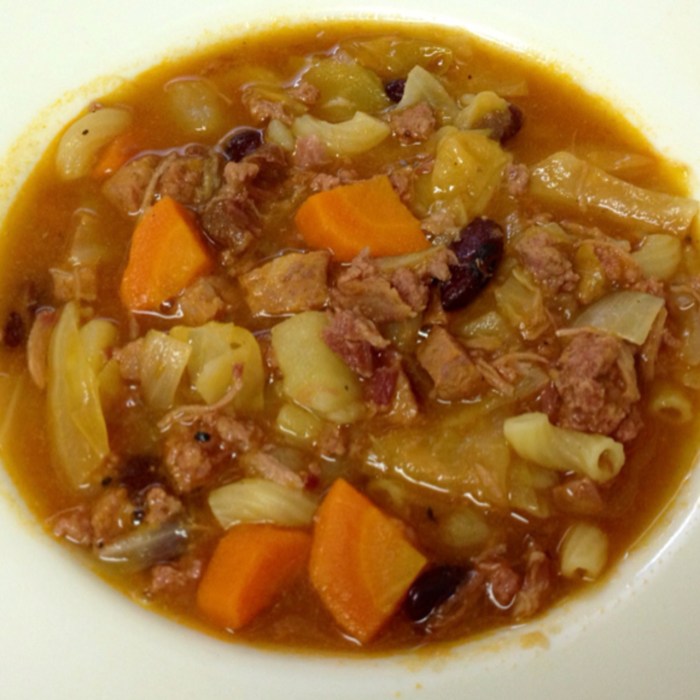A Diverse Culinary Landscape: Exploring Portuguese Soup Recipes
Portuguese soup recipes – Portuguese cuisine boasts a rich tapestry of flavors, and soups form a significant part of this culinary heritage. From hearty, rustic stews to delicate seafood broths, Portuguese soups reflect the country’s diverse geography and culinary influences. Their historical significance is deeply rooted in utilizing readily available ingredients, often reflecting seasonal changes and regional specialties. This exploration delves into the world of Portuguese soups, highlighting their variety, key ingredients, and traditional preparation methods.
Regional Variations in Portuguese Soup Recipes
The diverse geography of Portugal, ranging from the coastal regions to the mountainous interior, significantly impacts its culinary landscape. Coastal areas naturally feature abundant seafood in their soups, while inland regions emphasize hearty vegetable and meat-based broths. For example, the Minho region in northern Portugal is known for its rich Caldo Verde, while the Algarve in the south showcases vibrant seafood soups influenced by the Mediterranean.
The Azores and Madeira islands also contribute unique variations, often incorporating locally sourced ingredients and reflecting their volcanic landscapes.
Popular Portuguese Soup Types
| Soup Name | Key Ingredients | Regional Origin | Brief Description |
|---|---|---|---|
| Caldo Verde | Potatoes, collard greens, chouriço | Northern Portugal (Minho) | A simple yet flavorful soup, characterized by its creamy texture from the potatoes and the savory notes of chouriço. |
| Sopa de Cação | Shark meat, potatoes, onions, garlic, tomatoes | Coastal regions | A traditional shark soup, the flavor profile can vary depending on the type of shark used and regional spices. |
| Açorda de Marisco | Bread, seafood (shrimp, clams, mussels), coriander, eggs | Coastal regions | A unique seafood soup thickened with bread, offering a rich and creamy texture distinct from other seafood soups. |
| Sopa da Pedra | Various vegetables (cabbage, carrots, beans), meat (pork, chicken), bread | Alentejo region | A hearty, rustic stew-like soup, often prepared with locally sourced vegetables and meat. |
Caldo Verde: Preparation and Characteristics

Source: insanelygoodrecipes.com
Caldo Verde’s creamy texture comes primarily from the finely diced potatoes simmered in the broth. The collard greens add a slightly bitter yet refreshing counterpoint to the richness of the chouriço. Traditional preparation involves slowly simmering the potatoes until they are tender, then adding the greens and chouriço for the final stages of cooking. The soup is typically seasoned simply with salt and pepper, allowing the natural flavors of the ingredients to shine.
Sopa de Cação: Variations and Ingredients
Sopa de Cação, while featuring shark as its central ingredient, displays regional variations in flavor profiles. Some versions incorporate tomatoes for a richer, more acidic taste, while others rely on a simpler broth enhanced by garlic and onions. The type of shark used also impacts the texture and taste, with some varieties resulting in a firmer, chewier soup. The addition of spices like paprika can also add a distinctive regional touch.
Açorda de Marisco: Distinguishing Characteristics
The defining feature of Açorda de Marisco is its use of bread to thicken the broth, creating a creamy, almost porridge-like consistency. This sets it apart from other seafood soups that typically rely on other thickening agents or maintain a clearer broth. The addition of coriander provides a distinctive aromatic element, and the eggs are often incorporated at the end, enriching the texture and flavor.
Key Ingredients and Their Sourcing
Authentic Portuguese soups depend heavily on the quality and freshness of their ingredients. The emphasis is on sourcing local, seasonal produce whenever possible.
The Role of Chouriço in Portuguese Soups

Source: cloudinary.com
Portuguese soup recipes offer a delightful array of flavors, from the richness of Caldo Verde to the seafood delights of Caldeirada. For a different take on savory comfort food, consider the convenience of a meatloaf with onion soup mix recipe , which offers a similar depth of flavor, albeit in a different format. Returning to Portuguese cuisine, the variety and regional differences in their soups are truly remarkable.
Chouriço, a spicy Portuguese sausage, adds depth of flavor and a satisfying richness to many soups. Its smoky, savory notes perfectly complement the earthy flavors of potatoes and greens in Caldo Verde, and it adds a layer of complexity to other soups as well.
Potato Varieties and Their Impact
Different potato varieties contribute varying textures and flavors to the soup. Russet potatoes, for example, provide a creamy texture when simmered, while smaller, firmer potatoes might offer a more substantial bite.
Fresh Herbs and Their Preparation
Fresh herbs like parsley, coriander, and mint are integral to the aromatic profiles of many Portuguese soups. They are typically added towards the end of cooking to retain their vibrant flavors and colors.
Soup-Making Techniques and Methods
Preparing a flavorful Portuguese broth is fundamental to many soup recipes.
Preparing a Basic Portuguese Broth
- Sauté aromatics (onions, garlic) in olive oil until softened.
- Add meat (if using) and brown lightly.
- Add water or stock and bring to a boil.
- Reduce heat and simmer for at least an hour, skimming off any foam that rises to the surface.
- Strain the broth before using it in your chosen soup recipe.
Thickening Soup: Methods and Comparisons, Portuguese soup recipes
Several methods can thicken Portuguese soups. The most common is the use of potatoes, as seen in Caldo Verde. Other techniques include using bread (as in Açorda), or a roux (a mixture of butter and flour).
Seasoning and Flavor Balancing
Seasoning is crucial. Start with salt and pepper, then adjust according to the other ingredients. Taste as you go, ensuring a balanced flavor profile.
Adapting Recipes for Dietary Needs
Vegetarian and vegan adaptations are easily achieved by omitting meat and using vegetable broth. Vegan chouriço alternatives are also readily available.
Serving and Presentation of Portuguese Soups
A simple yet elegant table setting enhances the enjoyment of Portuguese soup.
Table Setting Components
| Component | Description |
|---|---|
| Soup Bowl | A rustic, earthenware bowl complements the traditional nature of the soup. |
| Spoon | A sturdy spoon is ideal for enjoying the hearty texture of many Portuguese soups. |
| Bread | A crusty bread, ideally a regional Portuguese variety, is perfect for soaking up the flavorful broth. |
| Olive Oil | A drizzle of high-quality olive oil adds a final touch of richness. |
Traditional Accompaniments
Crusty bread is a classic accompaniment, often used to soak up the flavorful broth. A drizzle of olive oil can add richness.
Serving Temperatures
Most Portuguese soups are best served hot, though some lighter variations may be enjoyed at room temperature.
Communal Meal Sharing
In Portugal, sharing soup is a communal act, often enjoyed with family and friends, reflecting the importance of togetherness and shared meals.
Variations and Modern Interpretations
Modern interpretations of traditional Portuguese soups often incorporate new ingredients or techniques while retaining the essence of the original recipes.
Ingredient Substitutions
- For those with gluten intolerance, gluten-free bread can be used in Açorda.
- Dairy-free alternatives can replace milk or cream in some recipes.
- Individuals with shellfish allergies should avoid seafood soups.
Fusion with Other Culinary Traditions
Portuguese soups have inspired fusion dishes, incorporating elements from other cuisines. For example, a Portuguese-inspired coconut milk soup with chouriço could offer a unique twist.
Innovative Portuguese-Inspired Soup Recipe
Caldo Verde with Roasted Sweet Potatoes and Kale: This recipe replaces traditional potatoes with roasted sweet potatoes for added sweetness and depth of flavor, while using kale instead of collard greens for a slightly more robust flavor profile. The chouriço remains a key ingredient, adding its signature savory notes. The roasting process enhances the natural sweetness of the sweet potatoes, creating a unique and delicious variation of the classic Caldo Verde.
Commonly Asked Questions
Are Portuguese soups typically spicy?
While some recipes might include a touch of spice, most Portuguese soups prioritize savory and umami flavors over intense heat. Spice levels vary regionally.
Can I substitute ingredients in Portuguese soup recipes?
Yes, many substitutions are possible. However, be mindful that altering key ingredients might affect the overall flavor profile. Consider using similar ingredients with comparable textures and tastes.
How long do Portuguese soups typically take to prepare?
Preparation time varies greatly depending on the recipe. Simpler soups might take 30-45 minutes, while more complex ones can take several hours, especially those requiring slow cooking.
Where can I find authentic Portuguese ingredients?
Specialty food stores, Portuguese markets, and online retailers often carry authentic Portuguese ingredients. Check local listings or search online for suppliers near you.
